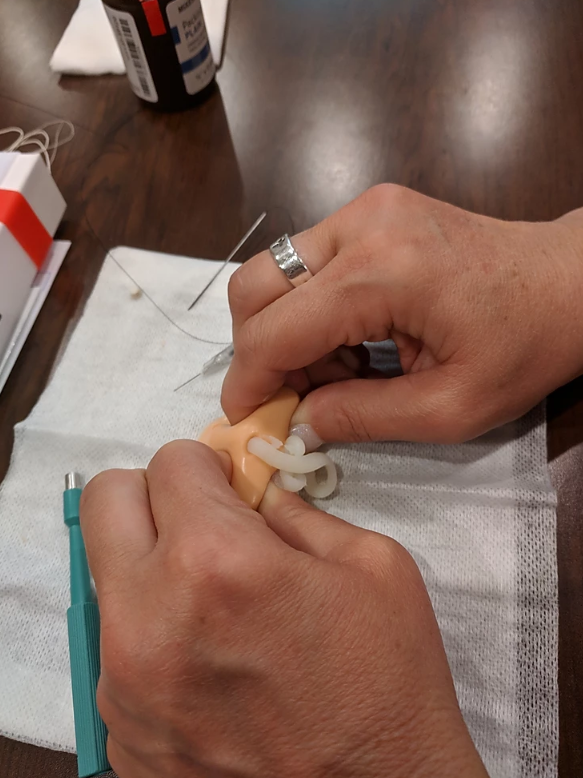Let’s discuss full practice authority for nurse practitioners. What it takes to undergo the process, and why you should apply once eligible.
Graduating NP school soon?
Get your final papers turned in, your clinical hours submitted, and your skills validated for privileging. Wait…how do I do that? What does that even mean?
Today, I want to talk to you about the poorly understood and even less-discussed process of verifying your training when getting that new job offer.
Consider this scenario:
You have found the “dream job”. You sail through the interview and fireworks go off. References are checked (your reference told you they were contacted) and you know something good is coming! You are waiting for the offer to be made and after a month later, you find out they passed you by for the job. “How did this happen”, you ask yourself? “I thought I was perfect for the job, and everyone else seemed like it too.” How did I read this so wrong?
Unfortunately, this happens more than you think. One reason it may happen is the credentialing process you rarely see behind the scenes of during any interview and offer process.
Let’s break it down:
Step #1 – You find the job you want.
Most likely in your specialty (and by that I mean a primary care job for a family nurse practitioner or an acute care/hospital based job for your adult gerontology acute care nurse practitioner).This job is a close enough fit that you are able to get an interview for the this and based on how many employers who work with many advanced practice clinicians tend to operate, there may be some overlap between PA or NP opportunity.
To get this far you need to have or be eligible to have prior to staring the job all the appropriate certification required for the role such as: prescriptive authority if in the job description, DEA license eligibility, state license eligibility, in most states, RN license (if an NP) of that state also, among other seemingly obvious necessary items to practice in the role. Some follow-on training may be necessary and that is fine, but should be defined in the interview.
Step #2 – You interview.
The employer and you both learn about one another and if it seems the role, training, expectations of call, work hours, productivity, or any other job-specific expectation are deemed within reason, you might proceed to an offer. (Note, if you want an inexpensive course designed to train you how to interview and negotiate as a new grad NP, check out our course HERE).
While you are eagerly waiting for an offer, the recruiting department will do a very in-depth review of your records and training, looking at references, work history, and certifications. Your best case scenario is that you have experience in the same role and have been previously credentialed and privileged in another system. But if you’re a new graduate NP, that will not be the case.
The best second you have to offer for skills validation is twofold: clinical time and recent work history. They realize that no recent work history as a RN will be identical to the role of a NP and the expanded privileges related to the role, but it does give a good idea of who you are and what types of environments in which you are familiar. As well, your clinical time can be a very useful tool to identify your patient-care exposure, with many systems such as Typhon providing a easily cataloged profile of your patient care hours for validating your preparation to enter a particular role. At this step, all of these are reviewed and collectively weighted to decide if you are a fit.
Step #3 – Offer made, offer accepted.
There is a conglomerate of those at this point who refuse the offer for whatever reason, but let’s focus on those who proceed to contract or hire, depending on your model and status of compensation. Now you wait. That wait is the mandatory pause between school ending or one job ending and your new role starting. Why the long pause? One Word: Credentialing.
Credentialing is the necessary process of making sure you are both eligible and prepared to work within a healthcare system and be a billable member of the system with the various insurance agencies involved and work within the confines of liability insurance, to put it simply. There’s much more to it than this, but for our purposes, you are going to wait for the hospital credentialing body to approve your hiring and privileging with the set of skills commiserate to your desired role. The credentialing committees tend to meet on regularly scheduled intervals and you will want to get your paperwork completed and submitted to meet the next possible meeting date or wait another few weeks or month.
NOTE: It is not unrealistic to see a standard wait time in the credentialing/privileging process of 60-90 days. Some roles can “fast track” or provide emergency privileges, but that is quite rare and because of this delay, you should plan you work role transition accordingly.
Step #4 – Skills Validation.
Somewhere in the mix of things, you learned some important skills and knowledge to justify you being certification-eligible. The majority of these skills are obvious: history and physical exam, patient assessment, prescription of medications, diagnosis, discharge summaries (if inpatient), or other similarly named skills. These skills are referred to now as your privileges. Some facilities will use the term “core” privileges to refer to the assumed baseline of all certified nurse practitioners and readily provide these when the skills validation process occurs before your start date.
There is a subset of skills you may have for your role that supersede this baseline of core privileges. This may include things for FNPs such as suturing, biopsies, EKG interpretation, casting, splinting, IUD insertion, vasectomy, incision and drainage, intraarticular aspiration and injection, small office procedures, to name a few. For acute care NPs, those privileges may be more along the lines of central line insertion, arterial line insertion, chest tube insertion, hemodynamic monitoring, order and manage intravenous fluids and vasopressors, blood administration, or a myriad of other job-specific skills.
These privileges MAY represent something you were taught in clinicals, but in many cases, are not taught with any level of mastery. In fact, most students have zero experience with procedural skills as they enter the professional role of NP respective to their certification.
Step #5 – Privileges Granted!
If you were fortunate enough to learn these skills in part or whole, great! Documentation is the key. Either learning these skills during clinical time or through independent training will be suffice if properly documented. Unfortunately, in many cases, even the core privileges which schools should be able to readily verify do so with a level of trepidation, particularly with online schools.
Online NP education, although very convenient for the working adult, comes at a price at this particular junction if there has been little or no human interaction with the faculty who will do the skills verification. A form is usually filled out by the program director or coordinator and because this typically is a scaled 1-5 or 1-10 rating, those administrators who have little to offer beyond a name on a paper have been giving “middle of the road” assessments of 3 on a 1-5 scale. This may be “satisfactory” by the scale’s intention, but for the privileging body, this may trigger a mandatory review in further detail.
When the student can provide real documentation of these skills, the process is greatly simplified. Also, when the teachers know the students better as with most in-person programs, the scored tend to be 4-5 on a 1-5 scale, and with confidence due to a more relational understanding of the student’s skillset.
Note: When a new NP has no training to suffice, many privileges can be granted with supervision. This requires a like-privileged individual to observe and train the individual on the job. This may or may not be the case in all practice settings and has a great deal of variety geographically. If there is a considerable demand for the job, and you represent a more complicated or uncertain privileging process, this may be why you did not get the job you thought was a sure-thing.
What can you do to avoid this?
Step #1 – Be involved with your education. Get to know your instructors and take the fullest advantage of their knowledge and desire to help you grow into a professional peer. There are those who are not as engaging and I promise if your goal is to be remembered for an online course, you will be easily remembered if you make an effort. Don’t be one of the herd.
Step #2 – Consider an in-person school if you know you have equal access to either. I say that tongue in cheek as an online NP school adjunct faculty. I see a benefit to the online education system and have benefited from that myself. I will also say this may be the Achilles heel of the online education system.
Step #3 – Document your training. Many cases this is built into your clinical logs. If not, keep a good record. It is your responsibility as a student to keep track of all your education. Period.
Step #4 – Seek school-based training for hands-on skills. This is where school-provided immersion days or in-person training for online schools and sim-labs for in-person schools are your friend. They represent not only an opportunity to get to know the skills well, but also to get to know the faculty well.
Step #5 – Seek independent training for hands-on skills. This is where companies like Skills On Point come in. Of all the students we support, 90% are within 1 year of graduation of NP school, either pre- or post-graduation. Many desire training before their clinicals and have zero opportunity at their school. Many want to get the skills they didn’t know they needed with their jobs they didn’t anticipate landing. Either way, we can provide you with the formalized evidence-based education you need to walk into the job interview confident in your skills and more importantly, documentation to prove you are prepared for the job.
We all have heard the saying “it’s not what you said you did, it’s what you can prove“.
As a new grad NP, you’ve proven your knowledge. You’re capable and skilled. Make sure you have the tools necessary to be successful.
That’s why our mantra is “Learn the skills, get the job”.
If you want more info on all the nursing CEU courses we offer designed to help new grad NPs successfully enter the market, check out www.skillsonpoint.com for more details. See you soon in a course!

Student learning some abscess incision/drainage techniques at one of our procedures courses. So gratifying.
Image credit: John Russell
About the Author
Dr. John Russell, DNP, APRN, FNP-BC, CCRN, RNFA is the owner of Skills On Point, LLC, a Rockford, IL-based education company providing expert-level advanced practitioner education courses to students of all medical levels and degrees around the country. Check out their courses and join the mailing list for exclusive discounts and course updates!




